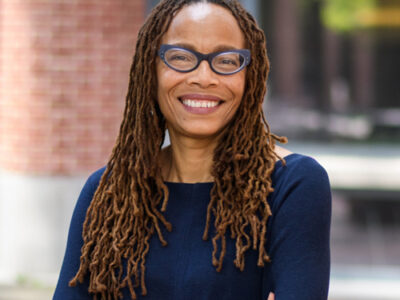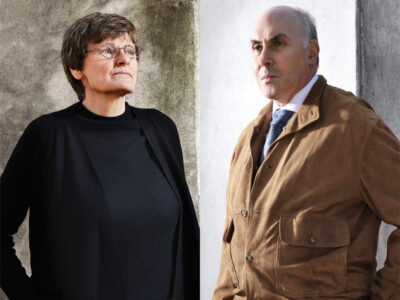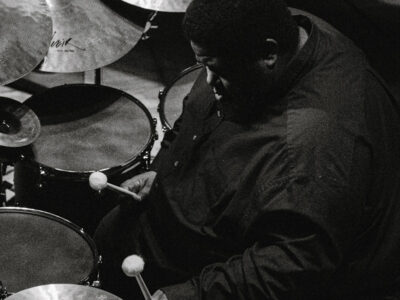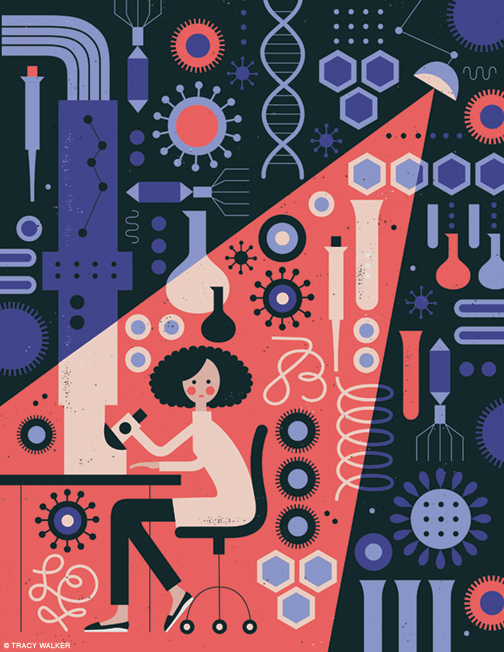
When SARS-CoV-2 struck, Susan Weiss was ready. The decades of work that she and a small cohort of fellow researchers have devoted to coronaviruses, despite limited funding and little respect, have been invaluable in speeding the search for treatments and vaccines. It’s been a rare stroke of good fortune in the current crisis—and a lesson in the importance of supporting basic science in anticipation of future ones.
By Julia M. Klein | Illustration by Tracy Walker
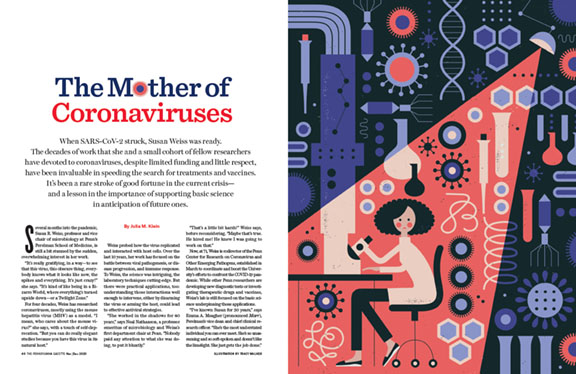
Several months into the pandemic, Susan R. Weiss, professor and vice chair of microbiology at Penn’s Perelman School of Medicine, is still a bit stunned by the sudden, overwhelming interest in her work.
“It’s really gratifying, in a way—to see that this virus, this obscure thing, everybody knows what it looks like now, the spikes and everything. It’s just crazy!” she says. “It’s kind of like being in a Bizarro World, where everything’s turned upside down—or a Twilight Zone.”
For four decades, Weiss has researched coronaviruses, mostly using the mouse hepatitis virus (MHV) as a model. “I mean, who cares about the mouse virus?” she says, with a touch of self-deprecation. “But you can do really elegant studies because you have this virus in its natural host.”
Weiss probed how the virus replicated and interacted with host cells. Over the last 10 years, her work has focused on the battle between viral pathogenesis, or disease progression, and immune response. To Weiss, the science was intriguing, the laboratory techniques cutting-edge. But there were practical applications, too: understanding those interactions well enough to intervene, either by disarming the virus or arming the host, could lead to effective antiviral strategies.
“She worked in the shadows for 40 years,” says Neal Nathanson, a professor emeritus of microbiology and Weiss’s first department chair at Penn. “Nobody paid any attention to what she was doing, to put it bluntly.”
“That’s a little bit harsh!” Weiss says, before reconsidering. “Maybe that’s true. He hired me! He knew I was going to work on that.”
Now, at 71, Weiss is codirector of the Penn Center for Research on Coronavirus and Other Emerging Pathogens, established in March to coordinate and boost the University’s efforts to confront the COVID-19 pandemic. While other Penn researchers are developing new diagnostic tests or investigating therapeutic drugs and vaccines, Weiss’s lab is still focused on the basic science underpinning those applications.
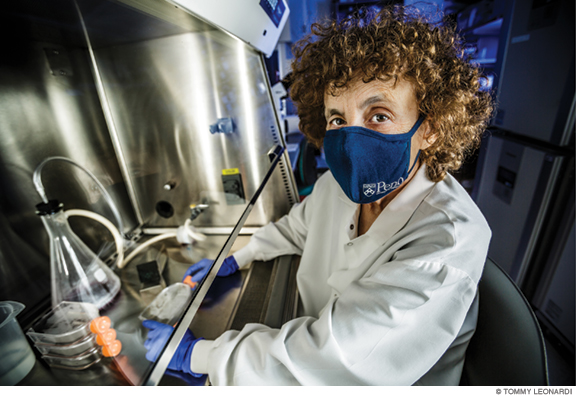
“I’ve known Susan for 30 years,” says Emma A. Meagher (pronounced Marr), Perelman’s vice dean and chief clinical research officer. “She’s the most understated individual you can ever meet. She’s so unassuming and so soft-spoken and doesn’t like the limelight. She just gets the job done.”
Like it or not, the limelight has found Weiss. “I’ve gotten to do some things that I never would have been asked to do before,” she said in May on the podcast This Week in Virology. “I think this is really exciting—it’s kind of rejuvenating me. I feel like I’m the mother of coronaviruses.”
In recent months, her long days of science have become longer still, packed with requests to keynote virtual coronavirus conferences, serve on celebrity science panels, guest on podcasts and webinars, and contribute to a BBC radio documentary, The Virus Hunters. And submit to interviews for articles like this one.
“I feel slightly embarrassed,” Weiss writes in an email. “It is just a weird accident that what I work on has become hot—after so many years of nobody caring about it.”
At 72, Julian L. Leibowitz, professor of microbial pathogenesis and immunology and director of the MD/PhD program at Texas A&M University, may be the world’s oldest active coronavirologist. As a young scientist, he chose the field, in part, because of “some magic words” from the virologist whose lab he inherited: “We’re just starting this project [on coronaviruses], and nobody knows anything about their molecular biology. So anything you do would be publishable.”
In 1978 or ’79—neither of them can quite recall the year—Leibowitz gave Weiss her first mouse hepatitis virus. Her first cell lines, too, in which to grow the virus. They have been friends and collaborators ever since.
They both like to reminisce about the first time he visited her, when she was a postdoctoral fellow in a prestigious virus lab at the University of California, San Francisco. Weiss and her then-partnerhad two cats. Leibowitz, an assistant professor at the University of California, San Diego, had a cat allergy. So, for a week, he pitched a tent in her yard—“cheaper and more convenient,” he figured, than a hotel.
“The coronavirologists as a group are really about as nerdy as you can get, especially the old ones,” says Leibowitz. “You started working on a virus that you worked on because you found it really interesting, because it was of no known medical importance. It was never going to make you famous. Now it might. Or at least make someone famous—probably not me.”
In the early days, he says, “This was a tiny field. I would say we were underappreciated because there was no significant human disease associated with it, so the amount of funding was relatively small.”
When Weiss gives her standard introductory lecture, she includes a timeline of coronavirus research. It began in the 1920s and ’30s, with the identification of respiratory illnesses in chickens and other animals caused by a family of pathogens that would eventually be dubbed coronaviruses. The name first appeared in a paper in 1968, after the discovery, through electron miscroscopy, of the characteristic corona of spikes prickling their surfaces. In the 1960s and ’70s, two coronaviruses, 229E and OC43, were linked to the common cold.
While researchers studying viruses such as herpes and HIV gathered annually to compare notes, there wasn’t sufficient interest in coronaviruses to justify yearly meetings. Held every three years, coronavirus conferences were cozy, congenial affairs, often in picturesque European settings. The first, in 1980, took place in a castle in Würtzberg, Germany. Weiss, then starting her assistant professorship at Penn, says there were 60 people there. Leibowitz remembers 72. “Who’s going to know the difference?” says Weiss. “You know what, I hate to tell you—half of them are probably dead. Julian and I were the youngsters, the assistant professors. We were the kids. I was 30.”
The quiet coronavirus decades ended with the 2002–03 outbreak of SARS (severe acute respiratory syndrome), which began in China. Like its genetically related successor, SARS-CoV-2, which causes the disease COVID-19, SARS-CoV originated in bats. It likely was passed to humans via civets, cat-like mammals native to Asia, Africa, and southern Europe. In the end, SARS caused just 8,069 known infections and 774 deaths, with the highest fatality rate in those 65 and over.
Before petering out, SARS jumpstarted a coronavirus research boom. With grant money suddenly flowing, more scientists entered the field. “The next international coronavirus meeting,” in 2003, in the North Sea resort of Egmond aan Zee in the Netherlands, “was completely sold out,” Leibowitz says. “They had reporters. It was crazy.”
SARS “gave us respectability and recognition,” says Weiss. “It’s silly. That’s what makes me angry—the idea that [the research] is not important until something like this happens.”
When federal money dried up in the US, some of the newcomers exited. Leibowitz, Weiss, and others carried on. In 2004 and 2006, researchers reported on two more coronaviruses causing human disease: NL63, responsible for croup and bronchiolitis, and HKU1, associated with pneumonia. A paper published in 2005 described bats as important reservoirs for SARS-like viruses.
In 2012 came another shock: an even deadlier disease, MERS (Middle East respiratory syndrome), appeared in Saudi Arabia. It, too, likely originated in bats, but the illness spread to humans by way of camels. MERS remained rare, but it hasn’t yet disappeared. As of January 2020, the World Health Organization had reported 2,519 cases, with 866 deaths, a fatality rate of more than 34 percent. “Maybe this should have warned us that coronaviruses may emerge in different ways and spread with different patterns,” Weiss writes in a recent Journal of Experimental Medicine article, titled “Forty years with coronaviruses.”
With each new human disease, interest in coronaviruses spiked. As cases subsided, grant money and interest declined. The field ebbed and flowed. “Mostly, it ebbed,” Weiss says.
In truth, the alarm had sounded, but very few people, it seemed, were listening. “So after SARS 1 and MERS we knew really well—twice—that this could happen,” Weiss says, “and yet there was no real emergency to take care of it. I mean, there was a group of people working on antivirals. But there was no real push by funding agencies to make this an important topic.”
The next part of the story is more familiar: in January, news broke of a “novel” coronavirus afflicting a few people in Wuhan, China, with pneumonia-like symptoms. On January 10, the New York Times chronicled the first known death, but, quoting a Wuhan health commission, said “there is no evidence that the virus can be spread between humans.” (Weiss says that coronavirologists knew better.) Ten days later, the Times did an about-face, reporting that a Chinese scientist had confirmed human-to-human transmission.
The initial reaction of the close-knit coronavirus community to SARS-CoV-2, Leibowitz says, is “best described as, ‘Oh, shit.’” Weiss says her response was “shock and not shock. Surprise—but thinking, ‘Well, we should have known.’”
Weiss had been preparing for this moment, perhaps without realizing it, much of her life.
The eldest of three children, she was born on the Upper West Side of Manhattan and raised in Yonkers, New York. Her 95-year-old mother is a retired teacher. Her late father owned a women’s clothing store, where Weiss “could get any clothes I wanted”—not that she much cared.
As a biology major at Brandeis University and, later, a graduate student in microbiology and molecular genetics at Harvard, Weiss worked in bacteriology labs. But she switched to virology, in part, because her preferred bacteriology lab was full. “There was a lot of serendipity involved,” she says. She did her doctoral dissertation on Newcastle disease virus, which kills chickens.
Bonnie Spanier, an associate professor emerita of women’s studies at the University at Albany, State University of New York, met Weiss in a Harvard Medical School virus lab before her own career took a humanistic turn. She describes her friend as “without guile.” Spanier remembers: “It was a time of competition in the sciences. Some of the women in graduate school were way worse than the men—really horrible. Susan was the opposite of that. She was a great member of the lab—a really super scientist, but always low-key and modest.”
After Harvard, Weiss joined what she calls a “pretty high-profile, high-stress lab in retroviruses” at UCSF, led by J. Michael Bishop, later chancellor of the university, and Harold E. Varmus, who would become director of the National Institutes of Health and the National Cancer Institute. That was several years before the discovery, in 1984, that a retrovirus, human immunodeficiency virus (HIV), caused AIDS. In 1989, Bishop and Varmus would share the Nobel Prize in Physiology or Medicine for their work on the origins of cancer. But, in the late 1970s, Weiss decided against pursuing research on either retroviruses or oncogenes (genes in retroviruses with the potential to cause cancer).
Instead, one day, in search of her future, she picked up the Journal of Virology and started paging through it.
“I found this field that really looked ready to be explored,” she says. “It had a really interesting animal model”—the mouse and MHV, whose different strains affected different mouse organs. There were human viruses, too—the ones that caused the common cold. “It was just ready for molecular biology,” Weiss says. “That was the time when molecular biology was burgeoning—you could do sequencing, and you could do cloning, and you could do stuff that you really couldn’t do on RNA viruses before.”
There was another advantage: “There weren’t a lot of people working in that field, so that was really appealing [to me] as an insecure woman. That wasn’t the reason I picked it, but that was a perk, that was a plus about the field—that it was pretty quiet. And it was just at the point where you could be right in almost from the beginning.”
Weiss credits Bishop with allowing her to initiate her own research in his lab. “He let me get a head start, which was really quite amazing and unusual,” she says.
She landed at Penn in 1980. “Susan came very highly recommended,” Nathanson says. She gained a reputation for mentoring young scientists, serving from 2010–19 as associate dean for postdoctoral research training.
Her first graduate student, Catherine Pachuk G’88, now chief scientific officer at a biotech company, remembers Weiss as “very calm, very persistent, and steady in her work,” and says “she basically shaped me as a scientist.” Weiss ran the lab “like a family,” Pachuk recalls, with regular outings to places such as Pennsylvania’s Hawk Mountain, Atlantic City, the Baltimore aquarium, and New York’s Little Italy.
Another former student, Scott Hughes G’96, deputy director of the Public Health Laboratory of the New York City Department of Health and Mental Hygiene, says that Weiss “really opened a lot of doors for me.” She possessed “a lot of drive and determination,” he says, and was “motherly, almost” to younger scientists in her orbit. (Weiss’s own family includes two sons from earlier marriages: Ari Felber, 37, a professional magician, and Jonathan Fraser C’12, 30, a resident physician who hastreated COVID-19 patients. She is marriedto Edward Ashare, a retired chemical engineer.)
Her “most exciting” research, Weiss says, involved a long-term collaboration with Robert H. Silverman, a professor of molecular medicine at the Cleveland Clinic Lerner College of Medicine of Case Western Reserve University. Working with MHV, Weiss says, “We discovered a new mechanism by which a virus can really shut down a host’s response.” They found, too, that “if the virus is mutated, it can no longer cause disease in a mouse.”
In a video introduction to a recent keynote talk at a conference on COVID-19 and women’s health, Weiss describes herself as only the second woman ever hired to a tenure-track position in Penn’s microbiology department. (Nathanson says she’s “probably correct” on that.) “I was maybe not getting paid as much as the men, or being given the same responsibilities,” she says. In retrospect, she wishes she had been “more assertive and not afraid to ask for what I needed”—and more demanding of her graduate students as well.
There were other frustrations. Beth Schachter, a New York-based science communications consultant and longtime friend, says that Weiss was “very distressed when a former chairman of hers”—not Nathanson, to whom she is close—“said, ‘Why don’t you publish in a more high-profile place?’”
Weiss confirms the story. “It has been harder to get coronavirus work in higher profile journals. Now, there are so many coronavirus papers in those journals! They’re not all good ones,” she adds. “I’m a little on the bitter side. Frankly, it’s really annoying to see that this field that we worked on so carefully for so many years was never considered ‘hot’ enough to be in the higher profile journals. And now it is.”
In The Virus Hunters documentary, Weiss expresses her frustrations even more directly. “Inside of me,” she says, “there’s just a little bit of saying, ‘Why didn’t we take this more seriously? Why didn’t you take me more seriously?’ Yes, that’s there.”
In March, when most other Penn science labs locked down, Weiss’s ramped up, even doing some hiring. “My lab never stopped,” she says.
She had been on sabbatical at Scripps Research in La Jolla, California,until early January, and she remembers first hearing about the novel coronavirus from a Chinese postdoctoral fellow. “We bought some PPE [personal protective equipment] to be prepared if we were going to study it,” she says.
At a February meeting in Barcelona titled Viruses 2020—Novel Concepts in Virology, Weiss recalls that “everything was sort of breaking open—all the Chinese people that were supposed to come to the meeting couldn’t come because of the virus.” As the only coronavirologist in attendance, Weiss gave a short talk on coronaviruses, “and all these Spanish newspaper people came to talk to me.”
Afterward, she and her husband embarked on a planned vacation to southern Spain—their last vacation, surely, for a while. The trip was punctuated by emails with “environmental health and safety people at Penn,” who were helping her obtain SARS-CoV-2 for her lab. In early March, she traveled to Harvard Medical School to give a seminar. She was there just days after the biotech company BioGen’s leadership conference in Boston, notorious now as an early COVID-19 super-spreading event.
“Then I came back, and that was the end—everything shut down,” Weiss says.
Weiss stayed mostly sequestered during Pennsylvania’s lockdown, emerging only around dawn from her suburban home for long walks and bike rides. “But I was working like crazy,” she says, juggling virtual lab meetings, grant proposals, seminars, and a constant stream of questions and requests. Suddenly, everyone wanted to collaborate with her; everyone wanted to know what she knew about coronaviruses. It was exhausting—and exhilarating.
In June, Weiss returned to the lab. “I feel like things are less stressful now,” she says. “I’m going to work most days. I, of course, wear my mask. The first day I went, it was pretty intimidating. I wore an N95 [mask]. I was really afraid to go to the bathroom—that freaked me out.”
Weiss says that the idea for the Penn Center for Research on Coronavirus and Other Emerging Pathogens came from her department chair, Frederic D. Bushman, the William Maul Measey Professor in Microbiology. Bushman is the center’s codirector.
The coronavirus center’s mission, Weiss says, is “really informational.” In addition, she says, “we’re hoping we can fund pilot projects, to get people to collaborate better, to get the basic scientists and the clinical scientists to work together—that’s always a goal.” Introducing Weiss at an April virtual symposium, the first of two sponsored so far by the center, J. Larry Jameson, executive vice president and dean of the Perelman School, likened her to “Superwoman.”(A colleague later emailed Weiss a digitally altered image of her in the DC Comics costume.)
The symposia, Weiss says, are aimed at educating the public, as well as other scientists—and spurring fundraising. Torren Blair, Perelman’s senior director of development for basic and translational science programs, says that, as of September, the center had received $600,000 in donations.
In addition to its current, high-security, Biosafety Level 3 lab for virus work, the center is building a BSL-3 laboratory for animal research to help test drugs and vaccines, Bushman says. His lab is studying what he calls “the functional genomics of SARS-CoV-2, including how viral genetics changes over time inside patients during treatment.” With Ronald G. Collman, professor of medicine and microbiology and director of the Penn Center for AIDS Research, Bushman also is investigating the effects of SARS-CoV-2 on the human microbiome. And he is helping to develop a new diagnostic test using saliva that is “quick and dirty,” but also “fast and cheap.”
Weiss says her current research focuses on the mechanisms by which viral proteins shut down host pathways. Because two-thirds of the RNA genome is common to all coronaviruses, “if you design a drug against one of those proteins,” she says, “it’s likely to work against all coronaviruses.” Remdesivir, which has been shown to shorten recovery time from COVID-19, is a good example, she says.
Weiss’s conversation speeds up as she gets deeper into the topic. “But the other part of the genome is completely different,” she says, “for the different lineages of viruses”—that is to say, for MHV, MERS-CoV, and the two SARS viruses. These genes, and the proteins for which they code, “give each one of these lineages a different character,” she says.
When RNA viruses replicate, Weiss explains, “they make double-stranded RNA.” The host, recognizing this replication as a danger signal, responds by activating antiviral pathways. SARS-CoV-2, she says, is less effective in shutting down those pathways than, for example, MERS—meaning that infection may be less likely to lead to detectable illness. This characteristic, she speculates, could account for the high rate of asymptomatic infections caused by the novel coronavirus, one of many viral mysteries yet to be unraveled.
There is another interesting wrinkle, which may explain the sometimes confusing course of the disease, which can subside and then erupt again with greater virulence. Host pathways, Weiss says, can be both antiviral and inflammatory: “So they’re good and bad. It’s not like black and white. You activate these pathways, and you may get rid of the virus, but the cell may die.” That’s what happens in the so-called cytokine storm.
Asymptomatic spread is this virus’s big advantage over its predecessors: it renders transmission that much harder to stop. “This virus is really optimized,” says Weiss. “I tell people that that’s the main reason it couldn’t possibly be man-made. Nobody could ever figure out how to make a virus like that—it’s just impossible.”
Nathanson says that Weiss’s career should be understood in the context of a fundamental debate “at a very high level, since 1950, about how biomedical research should be focused and funded.” The argument, he says, has been “between those who wanted to focus exclusively on the disease of the week, or the disease of the month, and people who said, ‘Nope, we need to put a lot of money into curiosity-driven basic research, because we have no idea what the next problem is going to be. And if we don’t do that, we will be unable to deal with the next disaster that comes along.’
“Susan,” he says, “is the poster child for this idea.” If she and others hadn’t persisted, “we would not have been able to grow the virus and understand how it works. The basic science has saved us years of research. If none had been done, we would have been helpless.”
Following her curiosity “is exactly what Susan did,” says Nathanson. “And it took 40 years for that to make a difference.”
Julia M. Klein, a cultural reporter and critic, writes frequently for the Gazette. Follow her on Twitter @JuliaMKlein.


